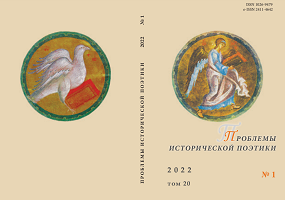Экфрастический код романа Леонида Леонова «Пирамида»
The Ekphrastic Code of “The Pyramid”, a Novel by Leonid Leonov
Author(s): Alexander A. Dyrdin, Julia V. ZhukovaSubject(s): Philosophy, Aesthetics, Russian Literature, Culture and social structure , Philology, Sociology of Art
Published by: Петрозаводский государственный университет
Keywords: Leonov’s poetics; the novel “The Pyramid”; ekphrasis; ekphrastic code; symbolic and philosophical thinking; allusion; verbal and figurative synthesis;
Summary/Abstract: The purpose of this article is to study the transformation of plots and motifs of visual art in “The Pyramid” (1994), the last novel by L. Leonov. The authors take a closer look at various types of ekphrasis: mimetic, unattributed and zero type. The theoretical framework for the analysis of the novel’s narrative space in ekphrastic terms includes the works of L.G. Geller, N.V. Braginskaya, J. Heffernan and other Russian and foreign philologists. Based on the idea of the dialogical nature of the concept of “ekphrasis,” the authors of the article consider the ekphrasis of the “The Pyramid” in a broad sense, as a means of concentrating the artistic, visual and philosophical context, inherent in the very nature of interaction between different types of art. The hermeneutic method is used achieve the set objectives, allowing to reconstruct the meanings of the ekphrastic fragments of the novel in the context of the phenomena of the global and Russian culture. Along with the alternation of dialogues and monologues of the implicit author and characters, direct and modified pictorial allusions are Leonov’s leading methods of text generation. Inheriting the traditions of Russian classical literature that tends to inexpressible, the writer integrates images of spatial arts, architecture, and painting into the text of the literary work. The narrative principles of “The Pyramid” are largely determined by the correlation of the author’s reflexive thought with precedent phenomena, the symbolic content of paintings by P. Brueghel, I. Repin, V. Perov, A. Durer’s engravings, temple frescoes, Russian icon painting. This allusive series is contingent on Leonov’s aesthetic preferences. It is on this basis that the ekphrastic code of the work is formed. It expresses the semantic and poetic harmony of the visual and verbal principles of the author’s thinking.
Journal: Проблемы исторической поэтики
- Issue Year: 20/2022
- Issue No: 1
- Page Range: 323-338
- Page Count: 16
- Language: Russian

